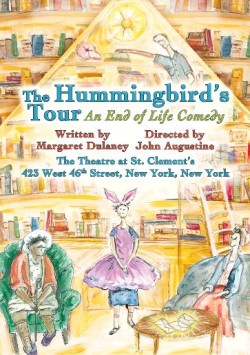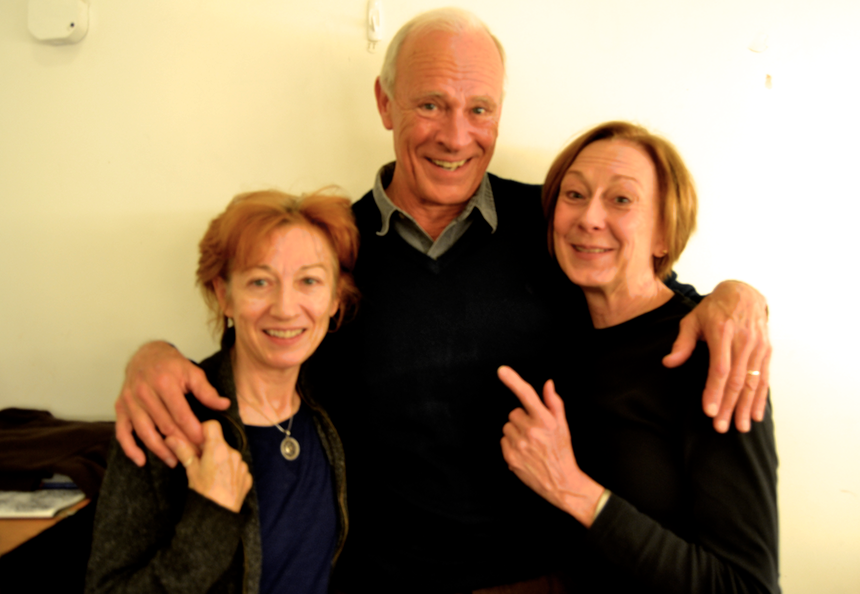
 In the calm moments backstage at St.Clements theater, hours before the first act of an off-broadway play, the cast of “The Hummingbird’s Tour” began to prepare themselves for a two-show day. To fill the time laughter fills the air as they reminisce on their experiences together and toss their own personal perspectives about life into the atmosphere.
In the calm moments backstage at St.Clements theater, hours before the first act of an off-broadway play, the cast of “The Hummingbird’s Tour” began to prepare themselves for a two-show day. To fill the time laughter fills the air as they reminisce on their experiences together and toss their own personal perspectives about life into the atmosphere.
“I pace,†said actor Ray Baker who plays the role of Norton. “Because I get so many butterflies that I have to burn up some kind of energy just so I don’t lose it.â€
‘The Hummingbird’s Tour” about life and all that is beyond it, is an off-Broadway play by playwright Margaret Dulaney and directed by John Augustine. The scene is set in Northern California in 1970. However, if you happen to be amongst the audience, you may be captivated by the realistic ’70s style living room. It is accentuated by an oversized library that stirs a strong urge of temptation to read the title of each book against the wall, old-fashioned style furniture, and a mini bar, that happens to be a world globe, filled with liquor bottles. This does not yet include the bonus decorations added throughout the play by the older sister, Lucy, who visits and leaves her mark of bohemian style scarves and drapery.
The cast consists of just four members. Ray Baker[Norton], Susan Pellegrino[Mattie] and Anne O’Sullivan[Constance] who represent a group of siblings in their mid-60s and each with a different attitude on life and what follows. Also, Lynda Gravatt[Constance] who plays the mother-like/nanny/maid/added family member who helped raise the siblings and she is not afraid to put them in their place. The bond between each character is evident, but it’s not exactly expressed in a sweet gentle way, neither is it harsh.
“Emotionally you have to be honest and bring yourself to this play as much as you can,†said O’Sullivan.
Between the sarcastic comments, flighty and child-like personalities, the siblings occasionally bicker at one another, throw pillows or stick their tongues towards the other sibling in a childish way that seems almost natural for the cast.
“They are 60-year-olds behaving like teenagers,†said Augustine, who describes the actions of the cast.
The two siblings who are played by Baker and Pellegrino receive a visit from their older sister a few days before Easter holiday.
O’Sullivan plays a character by the name of Lucy who is on a life-long journey of confusion and questions, but she may not admit that she’s confused.
“My personal life is not the same story at all; it’s the inner essence of it—the play is really rich,†admits O’Sullivan. “It’s an interesting journey.â€
She portrays a woman who has been married and then divorced and finds her way through life as she becomes a temporary leech on different religions. It is almost as if she picks up a habit of religions fleetingly and then drops them and moves onto the next.
Her visit to see her brother and sister seems to bring a sense of light into the home that might have been lost. Baker’s character Norton had lost his wife not too long ago due to a death and we see that he hasn’t been out of the house much since then.
“For me, I have to walk a wire between being just kind of cranky and irritable and being just an outright boorish, abusive creep,†said Baker. “The audience should like Norton even as they see that it would be very hard to have to live with him.â€
A grouchy brother and flamboyant sister, Mattie ties her way into this humorous equation of siblings with her ounce of quirkiness and childish mentality. Played by Pellegrino, Mattie is the youngest sibling who takes her label more serious than one would imagine, especially when you recall that these are adults in their 60s.
She is naive, but it’s effortlessly innocent that she can’t be judged even for her Easter outfit, which the family finds ridiculously hilarious. Her character has a warm heart, especially for the elderly at a nursing home she volunteers at, but her siblings later cause her to question herself.
“I think you bring a character different parts of yourself,†Pellegrino says about acting in comparison to real life. “ It’s not like you put something on. It’s not like a mask.â€
Dulaney began writing the play in her late thirties around 1995, but it took up to eighteen years before she decided it was time to reveal this comedic, real life story. Non-Fiction made an appearance in Dulaney’s life and so she believed that the door for theater had been closed. Initially, the play was first presented at a friend of Dulaney’s barn in Philadelphia as a gift to the neighborhood.
The play itself was inspired by her own spiritual journey and her grandmother’s life and style of speaking.
“She was such an unusual woman,†Dulaney expresses about her grandmother. “Such a fascinating person and I kept hearing her voice; it was her voice that inspired this play.â€
Dulaney is aware that she could have chosen any actors to play the role, but Dulaney believes that these actors were perfect for the job. With this being the third incarnation, it is more than just a production, but also a family. Dulaney notes that she would never do theater without Augustine.
“The cool thing about these actors,†Augustines adds. “It’s like you have a really fun sandbox where you can give a suggestion or create an idea and they’ll play with it.â€
Although it’s a comedy that is meant to uplift in humor, even cause you to laugh and discusses topics that are rather sensitive or difficult for some people, the casts put much time and effort to perfect their craft. This third incarnation has encouraged the cast to rehearse a lot more than they previously have in the past.
“We have rehearsed nine weeks for this three-week production,†said Dulaney.
For some of the characters like Pellegrino, Dulaney’s decision to emulate her grandmother’s language, to some extent was a challenge to learn. It’s not necessarily a different language aside from English per say, but how Dulaney chose for it to be said.
“The way she [Margaret] writes was really difficult for me,†said Pellegrino. “She has some colloquialisms that sound like Briticism.â€
From an audience perspective, it is seemingly effortless for the characters who play their role as if it was specifically made as an imitation of their lives. Although this story is based on the life of Playwright Dulaney, cast members such as O’Sullivan found the play to be much deeper than just the first read and relatable to their own life.
“I’ve been a spiritual seeker all my life,†said O’Sullivan.
‘The Hummingbirds Tour’ of theology, as Dulaney likes to label it, symbolizes the similarities between a person who is on an unending tour of self-discovery through religion to a hummingbird who lights up for 15-second intervals. It represents different journeys that we each take in life which can lead to an emotional breakdown or revolution.
“I didn’t want to offend,†said Dulaney. “ I wanted it to be all-embracive.â€
This funny, dramatic, tear-jerking play is well-rounded enough to welcome any type of audience. For Baker, who plays the role of Norton, there was a specific line in the play that physically stopped him in his tracks for a moment. It’s something that he relates to his own life.
As the play progresses and we learn why Norton behaves like he does, we begin to understand his sadness and his pain.
“We’ll have no more death,†Norton, played by Baker, said with a cracked tremble in his voice. “No more sad—sadness.†Baker’s character has a realization that is a turning point for him. Something that always sticks with him.
Performing isn’t something that is new to the cast, which is why Dulaney’s decision to select this particular cast has been a success. Some starting out in High School, it didn’t take long for them to grasp the fact that acting is their specialty. Dulaney gives the audience her life experience through a written performance but also tackles provoking questions that most people have.
Originally, the thought of baby-boomers being the majority audience was what Dulaney imagined.
That is not the case since she says that many people, especially those in their twenties, have come out and enjoyed the performance. Dulaney considers each character to be a part of her own self. Augustine, who dabbles in all aspects of theater, finds that it is simple for someone to relate to this play.
“I think the audience is anybody who has a sibling, anybody who has lost, anybody grieving,†said Augustine. “It says a lot about grief and every character has something to say.â€
This act covers comedy, family, love, faith, human desires and honesty. A desire to know what our future holds, a desire to grow and continuously learn. It creates an opportunity to question what matters the most to you. The play is currently running for three weeks at The Theater at St. Clements in New York City through Nov. 22, 2015.
“I think the play also says that you can search out something,†said Augustine. “And not apologize for it.â€
Photo by Saphia Capasso

Leave a Reply